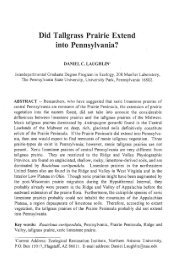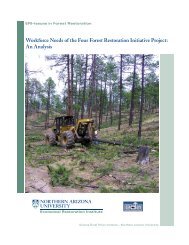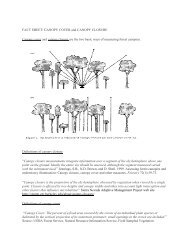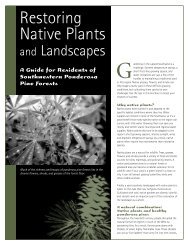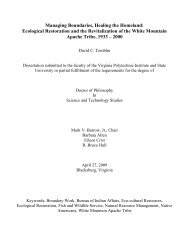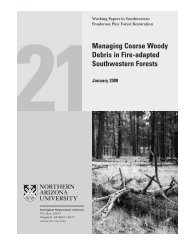- Page 1 and 2: Foreword by W. Wallace CovingtonEdi
- Page 3 and 4: ContentsACKNOWLEDGMENTSFOREWORDW. W
- Page 5 and 6: 5ForewordW. Wallace CovingtonThe dr
- Page 7 and 8: 7f Created and maintained an estima
- Page 9 and 10: 9IntroductionDave EganCollaborative
- Page 11 and 12: This handbook is designed to help t
- Page 13 and 14: 13fffffunds must primarily be used
- Page 15 and 16: 15Indian paintbrush (Castilleja kai
- Page 17 and 18: 17fffPotential threats to the healt
- Page 19 and 20: levels (i.e., within the historic/n
- Page 21 and 22: 21based reality”) that can be use
- Page 23 and 24: 23structural components and procedu
- Page 25 and 26: 25ffCycles/Patterns: Generally slow
- Page 27 and 28: make the project sustainable for th
- Page 29 and 30: Personal PerspectiveAs individuals,
- Page 31 and 32: 31Realist: Uses empiricism and indu
- Page 33 and 34: 33ReferencesAnderson, M.K. 2006. Te
- Page 35 and 36: U.S. Forest Service. 2011. U.S. For
- Page 37 and 38: 37These effortsfound support in anu
- Page 39 and 40: 39across large geographic areas, wh
- Page 41 and 42: 41Members of the stakeholder group
- Page 43: 43Barriers to Successful Collaborat
- Page 47 and 48: 47organizations or members of the p
- Page 49: 49informal discussion, and sharing
- Page 52 and 53: 52 CollaborationConnectivityThere a
- Page 54 and 55: 54 CollaborationCase studiesare pow
- Page 56 and 57: 56 CollaborationThomas, J.C. 1995.
- Page 58 and 59: 58 Ecological Economicsand the publ
- Page 60 and 61: 60 Ecological Economicsthe most imp
- Page 62 and 63: 62 Ecological EconomicsBox 1. The T
- Page 64 and 65: 64 Ecological EconomicsBox 2: Regio
- Page 66 and 67: 66 Ecological Economicsof the Rodeo
- Page 68 and 69: 68 Ecological Economicscollaborativ
- Page 70 and 71: 70 Ecological EconomicsBox 3: The R
- Page 72 and 73: 72 Ecological EconomicsClean, plent
- Page 74 and 75: 74 Ecological EconomicsThe Horse Pi
- Page 76 and 77: 76 Ecological EconomicsEconomicBarr
- Page 78 and 79: 78 Ecological EconomicsReferencesAl
- Page 80 and 81: 80 Ecological EconomicsKim, Y. and
- Page 82 and 83: Chapter3Planning and NEPADave Brewe
- Page 84 and 85: 84 Planning and NEPAThe Omnibus Pub
- Page 86 and 87: 86 Planning and NEPABox 1. NEPA Doc
- Page 88 and 89: 88 Planning and NEPAfffffffffftotal
- Page 90 and 91: 90 Planning and NEPATwo important a
- Page 92 and 93: 92 Planning and NEPAsilvicultural t
- Page 94 and 95:
94 Planning and NEPABox 2. Working
- Page 96 and 97:
96 Planning and NEPAPhotos 1-2. The
- Page 98 and 99:
98 Planning and NEPAthe project are
- Page 100 and 101:
100 Planning and NEPADetermine Sign
- Page 102 and 103:
102 Planning and NEPAneed for subst
- Page 104 and 105:
104 Planning and NEPACollaborationT
- Page 106 and 107:
106 Planning and NEPAIf monitoring
- Page 108 and 109:
Chapter4Multi-party MonitoringDave
- Page 110 and 111:
110 Multi-party Monitoringshall, in
- Page 112 and 113:
112 Multi-party Monitoringing is mo
- Page 114 and 115:
114 Multi-party MonitoringIssues to
- Page 116 and 117:
DESIGNPropose Broad GoalsDefine Per
- Page 118 and 119:
118 Multi-party MonitoringffffReduc
- Page 120 and 121:
120 Multi-party MonitoringTable 1.
- Page 122 and 123:
122 Multi-party MonitoringIdentify
- Page 124 and 125:
124 Multi-party Monitoringdecisions
- Page 126 and 127:
126 Multi-party Monitoringpartners
- Page 128 and 129:
128 Multi-party Monitoringactually
- Page 130 and 131:
130 Multi-party Monitoringand socia
- Page 132 and 133:
132 Multi-party Monitoringintake fo
- Page 134 and 135:
134 Multi-party MonitoringTable 2.
- Page 136 and 137:
136 Multi-party MonitoringWhite Mou
- Page 138 and 139:
138 Multi-party MonitoringConclusio
- Page 140 and 141:
140 Multi-party MonitoringChurchill
- Page 142 and 143:
Chapter5Contracting andImplementati
- Page 144 and 145:
144 Contracting and ImplementationE
- Page 146 and 147:
146 Contracting and Implementationf
- Page 148 and 149:
148 Contracting and ImplementationF
- Page 150 and 151:
150 Contracting and ImplementationA
- Page 152 and 153:
152 Contracting and ImplementationB
- Page 154 and 155:
154 Contracting and Implementationm
- Page 156 and 157:
156 Contracting and Implementatione
- Page 158 and 159:
158 Contracting and ImplementationB
- Page 160 and 161:
160 Contracting and Implementationi
- Page 162 and 163:
162 Contracting and ImplementationR
- Page 164 and 165:
164 Adaptive ManagementKey Concepts
- Page 166 and 167:
166 Adaptive ManagementSuccessful A
- Page 168 and 169:
168 Adaptive ManagementVarious Appr
- Page 170 and 171:
170 Adaptive Managementin managemen
- Page 172 and 173:
172 Adaptive ManagementTable 1. App
- Page 174 and 175:
174 Adaptive Managementtor, the app
- Page 176 and 177:
176 Adaptive Managementlandscape. T
- Page 178 and 179:
178 Adaptive Managementtions in a q
- Page 180 and 181:
180 Adaptive Managementpersonnel ma
- Page 182 and 183:
182 Adaptive Managementbe reluctant
- Page 184 and 185:
184 Adaptive Managementffffbe inclu
- Page 186 and 187:
186 Adaptive ManagementReferencesAl
- Page 188 and 189:
188 Adaptive ManagementJakeman, T.,
- Page 190 and 191:
190 Adaptive ManagementSchultz, C.
- Page 192 and 193:
192Each preceding chapter provides
- Page 194 and 195:
194back process and appropriate dec
- Page 196 and 197:
196Service, the Bureau of Land Mana
- Page 198 and 199:
198ResourcesArticles, Article Serie
- Page 200 and 201:
200USFS. 2012. Increasing the Pace
- Page 202 and 203:
202Compliance monitoring: A process
- Page 204 and 205:
204Ecosystem goods and services: Th
- Page 206 and 207:
206pursuits of past, present, and f
- Page 208 and 209:
208Networks: Loosely defined, heter
- Page 210 and 211:
210Scale: The degree of resolution
- Page 212:
212Trial-and-Error management: A st



